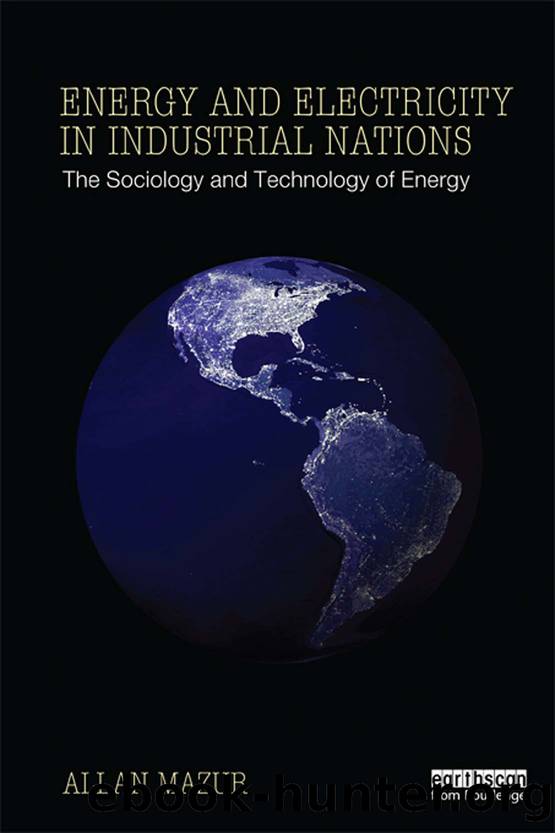Energy and Electricity in Industrial Nations by Mazur Allan;

Author:Mazur, Allan;
Language: eng
Format: epub
Publisher: Taylor & Francis Group
Conclusion
Did population growth or other causes most contribute to the rising use of energy and electricity in the industrial nations since 1960? The answer depends on the nation and how one interprets the question. Yearly fluctuations in TPES due to population growth averaged only one-sixth to one-half the magnitude of fluctuations due to nonpopulation factors. Thus, for a typical year in most nations, the population component was relatively small. However, in the 1970s and afterward, the yearly change in TPES due to nonpopulation factors was often negative, while the yearly change due to population growth, though smaller, was invariably positive. Therefore the cumulative effect of population growth from 1960 to 2008 eventually equaled or exceeded the cumulative effect of nonpopulation factors in the US, Canada, the UK, and Australia. Population growth, even viewed cumulatively, was relatively unimportant for the growth of TPES in France, Spain, Italy, and Japan. To some extent, this split is explained by relatively high population growth in Australia, Canada, and the US (but not the UK), and relatively low population growth in Japan, France, and Italy (but not Spain).
The situation of electricity is different. Here we can say without qualification that population growth was a minor driver of the rapid increase in electrification of all industrial nations, especially in the years prior to the energy crisis of the 1970s. On average, from 1960 to 2008, per capita consumption of electricity increased twice as fast as per capita TPES and nearly five times as fast as population, though rapid escalation has abated since the price rises of the 1970s.
It may seem puzzling that US population increase was an important driver of total primary energy consumption since 1960, but that population had only a modest effect on the growth of electricity consumption since 1960. This ostensible conundrum is explained by the year-to-year variation in TPES (net of population), sometimes rising, sometimes falling due to nonpopulation factors like oil prices. As a result, America's per capita consumption of TPES was lower in 2008 than in 1975. A continually larger share ofAmerica's yearly TPES was being used to generate electricity. Very soon the United States will devote half of its primary energy sources to the production of electricity, even more if there is a large move to electric cars.
A quick glance at Figure 7.3 might convey the impression that the US was uniquely frugal with energy after 1975, cutting its nonpopulation component of TPES growth more than any other industrial nation. This is correct in relative terms, but one must remember that American frugality began from an extraordinarily high base level of wastefulness, so it was relatively easy to eliminate the worst overuse by requiring, for example, higher miles-per-gallon automobile fleets. Most of the improvement was in the US industrial sector, partly due to a changing mix of goods produced, possibly also because energy-intensive industrial activities were moved to the Third World, and likely because inefficient pre-World War II industrial plants, which remained undamaged by the war and functional into the 1970s, could be closed down without serious economic loss.
Download
This site does not store any files on its server. We only index and link to content provided by other sites. Please contact the content providers to delete copyright contents if any and email us, we'll remove relevant links or contents immediately.
| Alternative & Renewable | Drilling Procedures |
| Electric | Fossil Fuels |
| Mining | Nuclear |
| Power Systems |
Whiskies Galore by Ian Buxton(41525)
Introduction to Aircraft Design (Cambridge Aerospace Series) by John P. Fielding(32885)
Small Unmanned Fixed-wing Aircraft Design by Andrew J. Keane Andras Sobester James P. Scanlan & András Sóbester & James P. Scanlan(32570)
Craft Beer for the Homebrewer by Michael Agnew(17930)
Turbulence by E. J. Noyes(7696)
The Complete Stick Figure Physics Tutorials by Allen Sarah(7135)
Kaplan MCAT General Chemistry Review by Kaplan(6592)
The Thirst by Nesbo Jo(6432)
Bad Blood by John Carreyrou(6271)
Modelling of Convective Heat and Mass Transfer in Rotating Flows by Igor V. Shevchuk(6219)
Learning SQL by Alan Beaulieu(6031)
Weapons of Math Destruction by Cathy O'Neil(5825)
Man-made Catastrophes and Risk Information Concealment by Dmitry Chernov & Didier Sornette(5644)
Digital Minimalism by Cal Newport;(5388)
Life 3.0: Being Human in the Age of Artificial Intelligence by Tegmark Max(5182)
iGen by Jean M. Twenge(5158)
Secrets of Antigravity Propulsion: Tesla, UFOs, and Classified Aerospace Technology by Ph.D. Paul A. Laviolette(4984)
Design of Trajectory Optimization Approach for Space Maneuver Vehicle Skip Entry Problems by Runqi Chai & Al Savvaris & Antonios Tsourdos & Senchun Chai(4837)
Electronic Devices & Circuits by Jacob Millman & Christos C. Halkias(4744)
